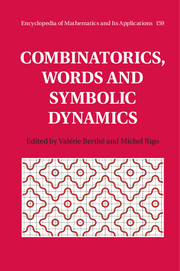Book contents
- Frontmatter
- Contents
- List of contributors
- Preface
- Acknowledgments
- 1 Preliminaries
- 2 Expansions in non-integer bases
- 3 Medieties, end-first algorithms, and the case of Rosen continued fractions
- 4 Repetitions in words
- 5 Text redundancies
- 6 Similarity relations on words
- 7 Synchronised automata
- 8 Cellular automata, tilings and (un)computability
- 9 Multidimensional shifts of finite type and sofic shifts
- 10 Linearly recursive sequences and Dynkin diagrams
- 11 Pseudo-randomness of a random Kronecker sequence. An instance of dynamical analysis
- Bibliography
- Notation index
- General index
8 - Cellular automata, tilings and (un)computability
Published online by Cambridge University Press: 05 January 2016
- Frontmatter
- Contents
- List of contributors
- Preface
- Acknowledgments
- 1 Preliminaries
- 2 Expansions in non-integer bases
- 3 Medieties, end-first algorithms, and the case of Rosen continued fractions
- 4 Repetitions in words
- 5 Text redundancies
- 6 Similarity relations on words
- 7 Synchronised automata
- 8 Cellular automata, tilings and (un)computability
- 9 Multidimensional shifts of finite type and sofic shifts
- 10 Linearly recursive sequences and Dynkin diagrams
- 11 Pseudo-randomness of a random Kronecker sequence. An instance of dynamical analysis
- Bibliography
- Notation index
- General index
Summary
Cellular automata are discrete dynamical systems based on local, synchronous and parallel updates of symbols written on an infinite array of cells. Such systems were conceived in the early 1950s by John von Neumann and Stanislaw Ulam in the context of machine self-reproduction, while one-dimensional variants were studied independently in symbolic dynamics as block maps between sequences of symbols. In the early 1970s, John Conway introduced Game-Of-Life, a particularly attractive two-dimensional cellular automaton that became widely known, in particular once popularised by Martin Gardner in Scientific American. In physics and other natural sciences, cellular automata are used as models for various phenomena. Cellular automata are the simplest imaginable devices that operate under the nature-inspired constraints of massive parallelism, locality of interactions and uniformity in time and space. They can also exhibit the physically relevant properties of time reversibility and conservation laws if the local update rule is chosen appropriately.
Today cellular automata are studied from a number of perspectives in physics, mathematics and computer science. The simple and elegant concept makes them also objects of study of their own right. An advanced mathematical theory has been developed that uses tools of computability theory, discrete dynamical systems and ergodic theory.
Closely related notions in symbolic dynamics are subshifts (of finite type). These are sets of infinite arrays of symbols defined by forbidding the appearance anywhere in the array of some (finitely many) local patterns. In comparison to cellular automata, the dynamic local update function has been replaced by a static local matching relation. Two-dimensional subshifts of finite type are conveniently represented as tiling spaces by Wang tiles. There are significant differences in the theories of oneand two-dimensional subshifts. One can implant computations in tilings, which leads to the appearance of undecidability in decision problems that are trivially decidable in the one-dimensional setting. Most notably, the undecidability of the tiling problem — asking whether a given two-dimensional subshift of finite type is non-empty — implies deep differences in the theories of one- and two-dimensional cellular automata.
In this chapter we present classical results about cellular automata, discuss algorithmic questions concerning tiling spaces and relate these questions to decision problems about cellular automata, observing some fundamental differences between the one- and two-dimensional cases.
- Type
- Chapter
- Information
- Combinatorics, Words and Symbolic Dynamics , pp. 241 - 295Publisher: Cambridge University PressPrint publication year: 2016



